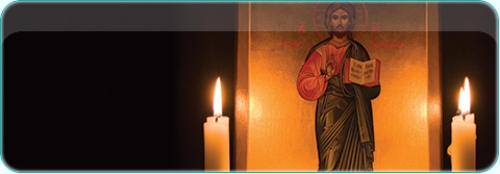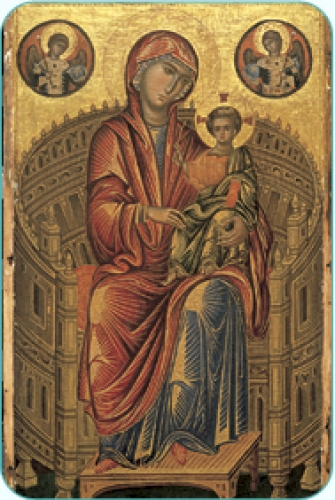The year is AD 1250. You live in a small Western European town and work according to the rising and the setting of the sun. It’s almost always cold, wet, and muddy. As you leave the firelight of your cottage, your eyes adjust to the oily-black night. You trudge down the path toward a building whose windows are spilling a warm, golden glow.
Inside the church, candles flicker under and around the paintings on the walls. There are images of Christ, the Virgin Mary, patron saints, and angels. Each figure in the paintings is radiant; light shines around their bodies, which seem to hover in a golden haze. Their robes are veined with golden streaks and splashes. The candlelight shines in the paintings’ gold backgrounds and gives them a shimmering depth.
Now the year is 2006. You stroll through an art museum and see the very same painting mounted on a bright white wall, lit by spotlights from above and below. You stop for a moment. Your eyes pass quickly over the mustard-hued background and you take in the rich reds and blues. Very pretty, you think, and move on to the next work.
“That’s exactly what you didn’t see in the Middle Ages,” Jaroslav Folda says. “No medieval person ever saw a work with electric spotlights on it. Nobody in the Middle Ages was making art to put in some museum, because there weren’t any museums.” It’s difficult for us to recreate the context of the works today, but back then, he says, “church was the best show in town.”
Writing in gold
The word chrysography literally means “writing in gold,” and originally referred to a technique employed by early Christian scribes who used gold ink to copy the Gospels of the Bible. The gold ink wasn’t just a sign of affluence — it actually brought light to the words on the page. The effect was almost magical, Folda says. When the owner opened the book, whatever light he used — usually candlelight — was immediately reflected, making the words glow and flicker.
While completing his most recent book, Crusader Art in the Holy Land, from the Third Crusade to the Fall of Acre, Folda began to realize that this gold highlighting — made of paint consisting of crushed gold mixed with egg tempera — was a crucial element in the Crusader icon paintings he was studying.
“No one talks much about chrysography,” Folda says. “Whenever anybody has anything to say about it, they say in their catalog entry for the work of art, ‘there’s gold highlighting on the figure in the following…’ But it opens up a wonderful new issue. It has to do with the fundamental interaction between the Byzantine East and the Latin West in the second half of the thirteenth century.”
Crusaders in the Holy Land
At the end of the eleventh century, Christians from the West enjoyed initial success in their attempt to seize territory from the hands of the Turks and Arabs. As they settled down to the first hundred years or so of life and war in what we know today as the Middle East, they assimilated some of the exotic habits of the local Christians — mostly Greek Orthodox but also Jacobite, Syrian Orthodox, and Armenian Orthodox. The Crusaders began to imitate the Byzantine style in manuscript illumination, mosaics, and frescoes. Eventually, the Eastern churches introduced the Crusaders to icon paintings — images through which artists revealed the power and divinity of holy figures.
Pilgrims visiting the Holy Land gave written accounts of beautiful icons used to adorn church walls, chapels, and altars. And because most of the Crusaders’ icon paintings are small — only a little larger than a sheet of notebook paper — we can guess they were also used around the home for personal worship. You must think about what a medieval painting was used for, Folda says, “because every medieval work of art essentially had a function.”
Greek Orthodox Christians immediately kissed their icon paintings upon entering their churches or houses. “Like when you walk into your grandparents’ home and you walk up to your grandmother and you give her a kiss,” he says. “It’s the same kind of thing. They thought of these icons in a very personal way.”
Artists, soldiers, and widows
The phrase ‘Crusader icon paintings’ may bring to mind an image of a soldier who, pausing briefly from swinging his sword or stringing his bow, dabs a quick watercolor on a spare bit of parchment. But not all Crusaders were fighters.
The Crusaders occupied the Holy Land for nearly two hundred years, and many who were born in the East to Crusader ancestry chose to decline the soldier’s life. Some took up apprenticeships in artists’ workshops and learned how to paint as the Byzantines did.
Icon painters were most often monks, nuns, and, later on, commercial artists trained to use a traditional technique to create holy images, which were in high demand. Patrons — bishops, priests, soldiers, wives, widows, mothers, or anyone else with the means to purchase the paintings — made specific requests when they commissioned the artists. Images of soldier saints, such as Saints Sergios and Bacchos, were particularly popular with military men and their families. Churches requested images of their patron saints. Wealthier clients ordered icons with more lavish chrysography. In Byzantium, Folda says, people had a psychological investment in their icons; they identified with the figures.
Church officials then consecrated the images. Their blessing transformed a painting from a holy image into a holy object with much greater liturgical and devotional worth. At this point, Folda says, the deeply spiritual Crusader found more than just the presence of wood and paint in his icon. Base matter became a mirror of the heavens, and the figure in the painting was a true reflection of a holy being.
A golden age in Italy
Folda believes that merchants and pilgrims passing through Italian port cities during the thirteenth century brought news to Italian painters of a new technique in the Crusader and Byzantine East. The Italians eagerly incorporated their own methods of golden highlighting into their panel paintings.
“There’s a difference in the way that chrysography is used in Byzantium versus the way it’s used in Italian panel painting,” Folda says. “The Byzantines saw light as evoking a spiritual reality.”
The Italians, who were mostly Latin Catholics, experimented instead with a new naturalism, how light falls over a three-dimensional figure. They used these images to tell stories from the Bible through altarpieces and other paintings in churches.
“If we can better understand chrysography,” Folda says, “we’ll understand more about the differing developments in medieval art and how it differs from Renaissance art.” Innovative Western European artists were keen to adopt the newest methods, but the transition from one style to the next subtly changed the use and purpose of chrysography. Art of the Maniera Greca, an Italian expression that means “in the manner of the Greeks,” was fashionable in Italy for a time. But by the sixteenth century, it had negative connotations, generally referring to a primitive or medieval approach — “medieval in a bad way,” Folda adds.
Unexplored territory
Art historical scholarship about the function of chrysography in painting is virtually nonexistent, but Folda is ready to enter into this unexplored territory. “What’s the purpose of this chrysography?” he asks. “Where did it come from? How did it develop? What is the art historical story about chrysography? No one’s written anything about it.”
Folda will present his research to graduate students of Italian art history at the University of Florence this summer, and he’s excited to show them what he’s found — that there’s a functional reason for chrysography in Byzantine, Crusader, and medieval Italian painting and that what looks like a muted yellow background and highlighting today is actually one of the work’s most vital elements.
In planning for his visit, Folda is contemplating a field trip with the students to an Orthodox church in Florence. “When you walk into a Byzantine church,” he says, “you’re leaving the natural world outside and you’re entering a sacred space. All of a sudden we switch gears. Our frame of reference is no longer the natural phenomenon of sunlight and color and space. It’s the sacred space of the church. We shift our notion of space, time, and reality, and experience a wholly spiritualized mode.”
Jaroslav Folda is N. Ferebee Taylor Professor of the History of Art at Carolina. His most recent book, Crusader Art in the Holy Land, from the Third Crusade to the Fall of Acre, was published by Cambridge University Press in 2005. He will present his research to students at the Istituto di Studi Umanistici at the University of Florence at a three-day conference in June, where the theme will be “the Experience of Icons and the Idea of Sacred Space.”






